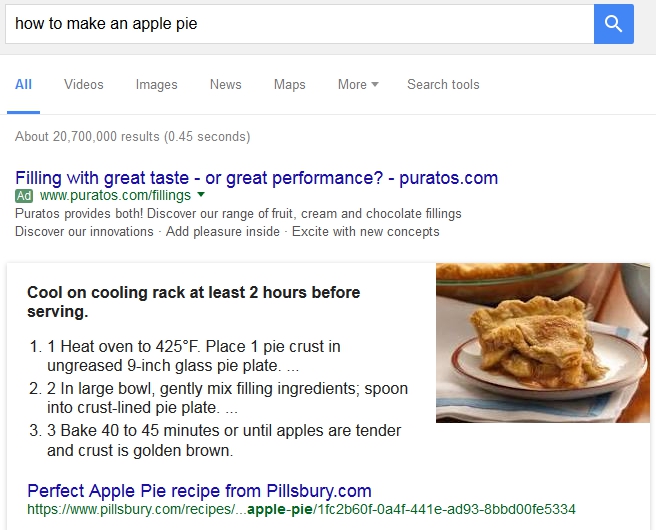In the past few years, Google has been working hard to efficiently deliver search results to users. In particular, the search giant has introduced several new ways of a website markup that allow displaying content in so-called rich search results. One of them is the “Articles” microformat that creates informative content snippets.
What is a snippet? What do you have to do to add your content there? How do you use structured data markup to deliver an “Articles” snippet? Well, let’s answer these questions and figure out why it is crucial to mark up content in order make it more visible in search.
What is a Snippet?
A snippet (also called a featured snippet) is a specific box used to display structured results in search. It enables users not to visit the actual web pages and get immediate answers to their questions on a search page.
Here’s an example for “how to make an apple pie”:

The snippet – the box with the step-by-step instructions on how to make a pie – pops up in search results due to a “Recipe” structured data markup on one of the pillsbury.com web pages. Snippets help users get access to the info they need quickly and easily, and thus websites that use structured data markup have much better chances to reach the top.
Why Should You Care about the Articles Snippet?
When search engine optimization professionals learned about featured snippets, their first conclusion was that they would take a toll on the click-through rate (CTR). Their logic was simple: If users can access web pages’ content right in search, they will not visit them. Fortunately, they were wrong.
Websites that rely on snippets have seen a huge boost in their CTRs. And it is quite easy to explain why:
-
Results with snippets are more noticeable on Google’s search pages;
-
They provide users with helpful information, incentivizing them to visit websites and learn more;
-
Google is likely to put websites that use markup above the others. Though it hasn’t been proved, the notion – at least theoretically – makes sense.
In short: if you mark up your blog posts and other info pages, their content is more likely to be pulled in featured snippets. It will help you rank higher for specific queries and keywords, attracting more visitors and increasing the CTR.
How Do You Mark Up to Get “Articles” Snippet?
To mark up your content, you need to use a structured data type called “Articles.” With its help you can easily add additional details such as headline, URL, short description, images, and publish date to your search results.
Here’s an example of a properly marked-up article in search:

A search for “hillary clinton” pulled the result above. It has a complete headline with URL, publisher, publication date, image and a short description. It takes more space on page and grabs users’ attention.
Make sure that your developers or SEOs include these properties in the content pages:
-
mainEntityOfPage – to specify URL
-
headline – to display an article’s headline
-
image – to pull a marked-up image from the article. Don’t forget to specify image.url, image.height and image.width.
-
publisher – to add the article’s publisher (i.e. The Guardian). You can specifically mark up publisher.name, publisher.log, publisher.logo.url, publisher.logo.height and publisher.logo.width as well.
-
datePublished – to indicate when the article was published
-
dateModified – to specify when the article was edited or modified
-
author (author.name) – to show who wrote the article
-
description – to add a short description to the search result
Having properly implemented properties is necessary if you want to display as much information in your search results as possible. However, this stuff is more technical (here’s the page for your developers) and has to do with how a website’s template is set up in the first place. Your job is to make sure that your snippets rank high on Google’s page one.
How Do You Rank High Using “Articles” Snippet?
To get your content displayed in featured snippets, you should not only mark it up properly but also optimize its structure. Here are several tips you need to follow:
-
Make sure that your articles feature high-quality backlinks. It demonstrates Google that the page is valuable, and it is safe to display more info from it.
-
Include targeted keyword(s) in headers. Google crawlers focus on headers to not only better understand a page’s structure but also get what it is about.
-
Use short paragraphs after the headers and ensure that they are placed within <p> tags. This helps Google figure out the header’s meaning as well; and, if it finds it useful enough, add up the paragraph into the snippet.
-
Break up your content with headings, subheadings and bullet points in numerical order. Google needs to display some kind of step-by-step instructions in its snippets – especially if they are question-based – and thus scans for words like “Step 1,” “Tip 1,” “Point 1.” This way, a whole paragraph from your article can be featured in the snippet.
However, the most important aspect is keywords. Run a detailed keyword analysis to make sure that your content features question-based, longtail keywords. If the answer is no, reoptimize the content following the tips I have given above.
